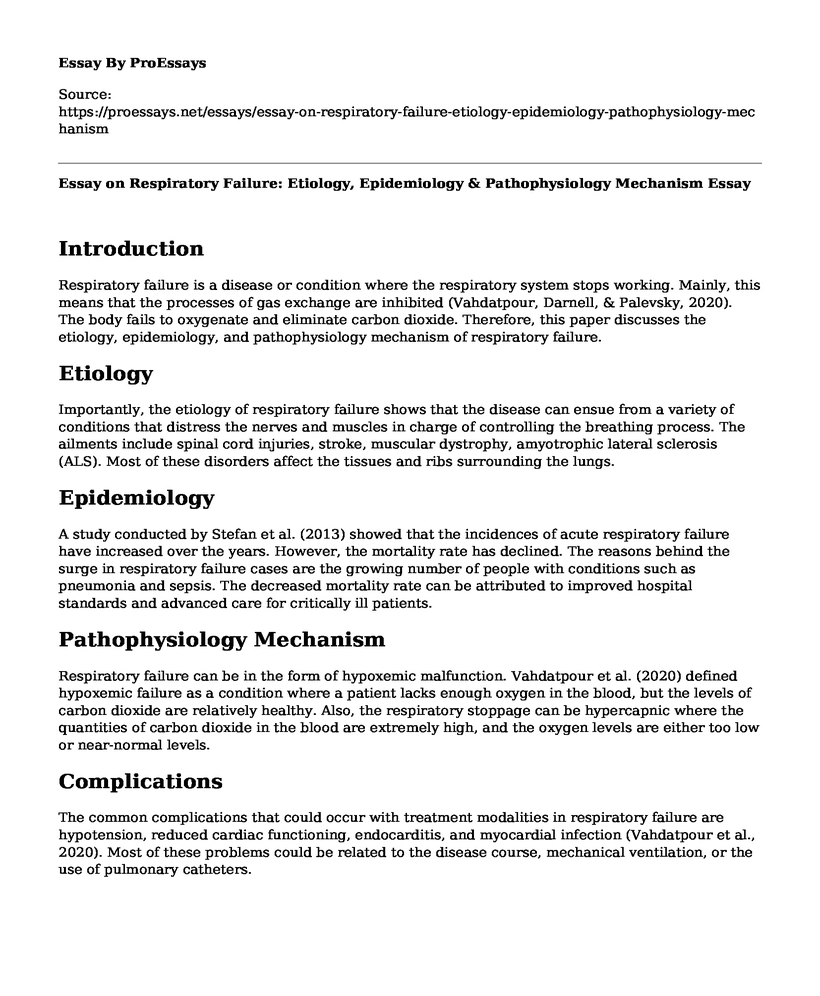Introduction
Respiratory failure is a disease or condition where the respiratory system stops working. Mainly, this means that the processes of gas exchange are inhibited (Vahdatpour, Darnell, & Palevsky, 2020). The body fails to oxygenate and eliminate carbon dioxide. Therefore, this paper discusses the etiology, epidemiology, and pathophysiology mechanism of respiratory failure.
Etiology
Importantly, the etiology of respiratory failure shows that the disease can ensue from a variety of conditions that distress the nerves and muscles in charge of controlling the breathing process. The ailments include spinal cord injuries, stroke, muscular dystrophy, amyotrophic lateral sclerosis (ALS). Most of these disorders affect the tissues and ribs surrounding the lungs.
Epidemiology
A study conducted by Stefan et al. (2013) showed that the incidences of acute respiratory failure have increased over the years. However, the mortality rate has declined. The reasons behind the surge in respiratory failure cases are the growing number of people with conditions such as pneumonia and sepsis. The decreased mortality rate can be attributed to improved hospital standards and advanced care for critically ill patients.
Pathophysiology Mechanism
Respiratory failure can be in the form of hypoxemic malfunction. Vahdatpour et al. (2020) defined hypoxemic failure as a condition where a patient lacks enough oxygen in the blood, but the levels of carbon dioxide are relatively healthy. Also, the respiratory stoppage can be hypercapnic where the quantities of carbon dioxide in the blood are extremely high, and the oxygen levels are either too low or near-normal levels.
Complications
The common complications that could occur with treatment modalities in respiratory failure are hypotension, reduced cardiac functioning, endocarditis, and myocardial infection (Vahdatpour et al., 2020). Most of these problems could be related to the disease course, mechanical ventilation, or the use of pulmonary catheters.
Conclusion
To conclude, respiratory failure is an ailment where the respiratory fails to oxygenate the body or remove excess carbon dioxide from the organs. Some of the causes relate to the damages caused to the tissues and ribs near the lungs. The disease epidemiology showed a decline in the mortality rate due to advanced and improved medical care.
References
Stefan, M. S., Shieh, M.-S., Pekow, P. S., Rothberg, M. B., Steingrub, J. S., Lagu, T., & Lindenauer, P. K. (2013). Epidemiology and outcomes of acute respiratory failure in the United States, 2001 to 2009: A national survey. Journal of Hospital Medicine, 8(2), 76-82. doi: 10.1002/jhm.2004
Vahdatpour, C. A., Darnell, M. L., & Palevsky, H. I. (2020). Acute respiratory failure in interstitial lung disease complicated by pulmonary hypertension. Respiratory Medicine, 161. doi: 10.1016/j.rmed.2019.105825
Cite this page
Essay on Respiratory Failure: Etiology, Epidemiology & Pathophysiology Mechanism. (2023, Apr 06). Retrieved from https://proessays.net/essays/essay-on-respiratory-failure-etiology-epidemiology-pathophysiology-mechanism
If you are the original author of this essay and no longer wish to have it published on the ProEssays website, please click below to request its removal:
- Pharmacotherapy for Respiratory Disorder Essay
- Essay Sample on Coaching International Workers Who Experience Burnout and Stress Problems
- Current Reproductive and Health Knowledge - Essay Sample
- Essay Example on Ethical Issues in Clinical Trials: Informed Consent and Beyond
- Black Death Plague: A Devastating Pandemic in History - Research Paper
- Strengths Perspective Theory in Social Work: 1980s Origins - Essay Sample
- Civic Education in K-6 and 9th Grade: Essential for Effective Participation in Public Life - Essay Sample







